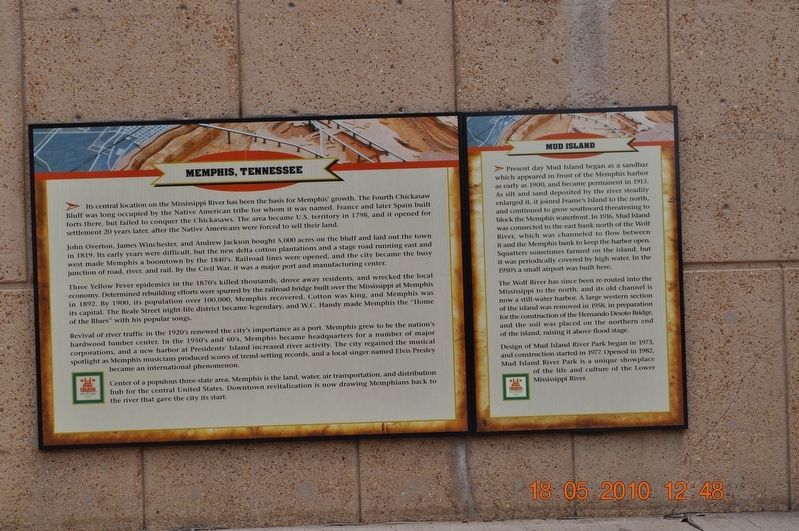Memphis,Tennessee/Mud Island
Memphis, Tennessee
Its central location on the Mississippi River has been the basis for Memphisís growth. The fourth Chickasaw Bluff was long occupied by the Native American tribe for whom it was named. France and later Spain built forts there but failed to conquer the Chickasaws. The area became U. S. Territory in 1798, and it opened for settlement 20 years later, after the Native Americans were forced to sell their land.
John Overton, James Winchester, and Andrew Jackson bought 5,000 acres on the bluff and laid out the town in 1819. Its early years were difficult, but the new delta cotton plantations and a stage road running east and west made Memphis a boomtown by the late 1840ís. Railroad lines were opened, and the city became the busy junction of road, river, and rail. By the Civil War, it was a major port and manufacturing center.
Mud Island
Present day Mud Island began as a sandbar which appeared in front of the Memphis harbor as early as 1900 and became permanent in 1913. As silt and sand deposited by the river steadily enlarged it, it joined Frameís Island to the north and continued to grow southward threatening to block the Memphis waterfront. In 1916, Mud Island was connected to the east bank north of the Wolf River, which was channeled to flow between it and the Memphis bank to keep
The Wolf River has since been re-routed into the Mississippi to the north, and its old channel is now a still-water harbor. A large western section of the island was removed in 1958, in preparation for the construction of the Hernando Desoto Bridge, and the soil was placed on the northern end of the Island, raising it above flood stage.
Design of Mud Island River Park began in 1973, and construction started in 1977. Opened in 1982, Mud Island River Park is a unique showplace of the life and culture of the Lower Mississippi River.
Three Yellow Fever epidemics in the 1870ís killed thousands, drove away residents and wrecked the local economy. Determined rebuilding efforts were spurred by the railroad bridge built over the Mississippi at Memphis in 1892. By 1900, its population over 100,000, Memphis recovered. Cotton was king, and Memphis was its capital. The Beale Street night-life district became legendary and W. C. Handy made Memphis the “Home of the Blues” with his popular songs.
Revival of river traffic in the 1920ís renewed the cityís importance as a port. Memphis grew to be the nationís hardwood lumber center. In the 1950ís and 60ís, Memphis became headquarters for a number of major
corporations, and a new harbor at Presidentsí Island increased river activity. The city regained the musical spotlight as Memphis musicians produced scores of trend-setting records, and a local singer named Elvis Presley became an international phenomenonTopics. This historical marker is listed in these topic lists: Native Americans • Railroads & Streetcars • Settlements & Settlers • Waterways & Vessels. A significant historical year for this entry is 1819.
Location. 35° 8.968′ N, 90° 3.507′ W. Marker is in Memphis, Tennessee, in Shelby County. Marker is on Riverside Drive. Mud Island Mississippi Riverwalk. Touch for map. Marker is in this post office area: Memphis TN 38103, United States of America. Touch for directions.
Other nearby markers. At least 8 other markers are within walking distance of this marker. The Mississippi Riverwalk (here, next to this marker); Ohio River (here, next to this marker); Cairo, Illinois (here, next to this marker); Islands No. 2, 3, and 4 / Fort Jefferson, Kentucky / Birdís Point, Missouri (here, next to this marker); Island No. 5 (Wolf Island)/Belmont, Missouri/Columbus, Kentucky (here, next to this marker); Donaldson Point, Missouri/Island No. 8/Hickman, Kentucky/Dorena Crevasse (here, next to this marker); New Madrid, Missouri/Cates Casting Field/Island No. 10 (here, next to this marker); Tiptonville, Tennessee/Bixby Towhead (here, next to this marker). Touch for a list and map of all markers in Memphis.
Also see . . .
1. Mud Island, Memphis. Mud Island (not actually an island) is a small peninsula, surrounded by the Mississippi River to the west and the Wolf River Harbor to the east. In 1960, the Wolf River was diverted so that it flows into the Mississippi River north of Mud Island. Mud Island River Park, located on the south end of the island, opened to the public in 1982. It is located within the Memphis city limits, 1.2 miles from the coast of downtown, and houses a museum, restaurants, and an amphitheater. It is accessible by the Memphis Suspension Railway (a monorail), by foot (via a footbridge located on top of the monorail), by ferry, or automobile (Submitted on March 14, 2018, by Sandra Hughes Tidwell of Killen, Alabama, USA.)
2. Memphis, Tennessee. Memphis was founded in 1819 as a planned city by a group of wealthy Americans including John Overton and future president Andrew Jackson.[6] The plantation economy of the Antebellum South established Memphis as a major domestic trading post for African-American slave labor and agricultural commodities, especially cotton.[7] Memphis seceded with Tennessee in 1861 during the American Civil War but was recaptured by Union forces in 1862 and occupied for the duration of the war. Home to Tennessee's largest African-American population, Memphis played a prominent role in the American civil rights movement and was the site of Dr. Martin Luther King, Jr.'s 1968 assassination. (Submitted on March 14, 2018, by Sandra Hughes Tidwell of Killen, Alabama, USA.)
Credits. This page was last revised on March 17, 2018. It was originally submitted on March 14, 2018, by Sandra Hughes Tidwell of Killen, Alabama, USA. This page has been viewed 369 times since then and 44 times this year. Photo 1. submitted on March 14, 2018, by Sandra Hughes Tidwell of Killen, Alabama, USA. • Bill Pfingsten was the editor who published this page.
